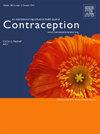为巴尔的摩拉丁裔/É患者提供以患者为中心的避孕护理
IF 2.3
2区 医学
Q1 OBSTETRICS & GYNECOLOGY
引用次数: 0
摘要
目的:我们旨在评估患者特征与接受以患者为中心的避孕护理之间的关系。方法:我们通过对四家医院的六名临床医生的录音访问,评估15-45岁的拉丁裔/本文章由计算机程序翻译,如有差异,请以英文原文为准。
PROVISION OF PATIENT-CENTERED CONTRACEPTIVE CARE FOR BALTIMORE LATINA/É PATIENTS
Objectives
We aimed to assess the association between patient characteristics and receipt of patient-centered contraceptive care among a sample of Latina/é patients in Baltimore, MD.
Methods
We assessed receipt of patient-centered contraceptive care among Latina/é patients aged 15-45 by audio-recording visits with six clinicians across four facilities. Patient-centeredness was assessed via analysis of the audio recordings using the Four Habits Coding Scheme (4HCS). Patients completed surveys using the Patient Centered Contraceptive Counseling (PCCC) measure. Multivariable logistic regression models tested the association between patient characteristics and PCCC and 4HCS scores. Qualitative interviews with a patient subset further characterized their experiences.
Results
A total of 52 visits and 29 interviews were analyzed. Some 64% of patients reported the highest possible ratings of patient-centered contraceptive counseling (PCCC). Researcher-reported 4HCS scores were notably less reflective of true patient-centered care provision. In adjusted models, neither PCCC nor 4HCS scores were significantly associated with patient characteristics. The discrepancy between PCCC and 4HCS scores is contextualized by interviews in which patients explain that compared to previous healthcare experiences, counseling received during the study period focused on their contraceptive preferences and involved interactions with kind, communicative clinicians/staff.
Conclusions
Positive ratings of experiences by Latina/é patients in the context of suboptimal patient-centered care on audio recordings suggests there may be a “low bar” of care, particularly for historically and currently marginalized groups. Provision of patient-centered contraceptive care requires attention to both patient-reported experiences and researcher-observed quality measures.
求助全文
通过发布文献求助,成功后即可免费获取论文全文。
去求助
来源期刊

Contraception
医学-妇产科学
CiteScore
4.70
自引率
17.20%
发文量
211
审稿时长
69 days
期刊介绍:
Contraception has an open access mirror journal Contraception: X, sharing the same aims and scope, editorial team, submission system and rigorous peer review.
The journal Contraception wishes to advance reproductive health through the rapid publication of the best and most interesting new scholarship regarding contraception and related fields such as abortion. The journal welcomes manuscripts from investigators working in the laboratory, clinical and social sciences, as well as public health and health professions education.
 求助内容:
求助内容: 应助结果提醒方式:
应助结果提醒方式:


